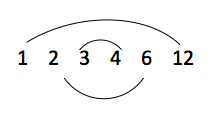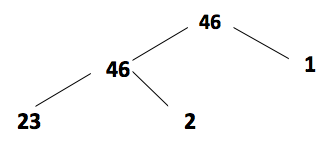What is a factor?
What is a factor? Factors are whole numbers that divide exactly into other whole numbers.
For example:
The factors of 12 are: 1, 2, 3, 4, 6 and 12.
1 x 12 = 12
2 x 6 = 12
3 x 4 = 12
We can then say that 12 is a multiple of 1, 2, 3, 4, 6 and 12.
Multiples can be thought of as extended times tables, for example: the multiples of 8 are all the numbers in the 8 times table: 8, 16, 32, 64, 128 etc.
Factors come in pairs that multiply together to form a certain number, this is easily demonstrated in a rainbow diagram like below:

This shows the pairs of factors which multiply to equal 12.
A helpful way for children to visualise the factors of a number is by drawing factor trees. These diagrams are also useful when children are asked to look for factors that different numbers have in common. Here is a factor tree for the number 46:

When do children learn about factors?
Children are actually learning about factors from Year 1 onwards when they start learning to count. Learning times tables is steadily introduced throughout Years 2 and 3, and in Year 4 children are expected to have learnt all the times tables up to 12.
In Year 4 the term ‘factor’ will be used, and children may have practice questions to complete like the example below:
Out of the following numbers, find two pairs of factors which multiply to equal 42
3 x 14 9 x 5 2 x 24 6 x 7
The answers are: 3 x 14 and 6 x 7.
How does a knowledge of factors help children with other mathematical concepts?
A good knowledge of factors is helpful for children in Year 5 onwards, as this is when they progress onto learning about prime numbers and square numbers. Children also need to understand factors before they can go on to learn about the highest common factor.
In Year 6 children should be confident in their knowledge of times tables and factors, as they will be expected to answer more complex questions and puzzles.
An example question might be:
I am a number less than 40. The sum of my digits is 8 and one of my factors is 7. What number am I?
To find the answer to this puzzle, children can use their knowledge of the 7 times table. They may write down all the multiples of 7 which are less than 40:
7, 14, 21, 28 and 35
Then they can see which of these numbers has digits that equal 8. As 3 + 5 = 8, the answer is 35.
How does Learning Street help children with factors?
Learning Street will introduce factors to the children slowly. This will be combined with regular practice in order that it is understood before then beginning to develop their knowledge and extend it further, as well as constant revision so that it isn’t forgotten.
Our Courses
Click through to review the courses we have available
- Independent School 11 Plus Exam Preparation Courses
- Grammar School 11 Plus Exam Preparation Courses
- Primary School Improvement/Development Courses
Our 11 Plus Mock Exam Papers
Berkshire Reading 11 Plus Mock Exam Papers
Kendrick 11 Plus Mock Exam Papers Bundle ( packs 1-4)
Reading School ( FSCE) 11 Plus Mock Exam 1
Reading School ( FSCE) 11 Plus Mock Exam 2
Reading School ( FSCE) 11 Plus Mock Exam 3
Reading School ( FSCE) 11 Plus Mock Exam 4
Reading School ( FSCE) 11 Plus Mock Exam Papers Bundle (packs 1-4)
Berkshire Slough 11 Plus Mock Exams
Slough 11 Plus Mock Exam Papers Bundle (Packs 1-4)
Barnet 11 Plus Mock Exams
Henrietta Barnett 11 Plus Mock Exam 1
Henrietta Barnett 11 Plus Mock Exam 2
Henrietta Barnett 11 Plus Mock Exam 3
Henrietta Barnett 11 Plus Mock Exam 4
Henrietta Barnett 11 Plus Mock Exam Papers Bundle ( Packs 1-4)
QE Boys 11 Plus Mock Exam Papers Bundle (packs 1-4)
Bexley 11 Plus Mock Exams
Bexley 11 Plus Mock Exam Papers Bundle (packs 1-4)
Bromley 11 Plus Mock Exams
Newstead Wood School Mock Exam 1
Newstead Wood School Mock Exam 2
Newstead Wood School Mock Exam 3
Newstead Wood School Mock Exam 4
Newstead Wood School Mock Exam Papers Bundle ( Packs 1-4)
St Olave’s Grammar School Mock Exam 1
St Olave’s Grammar School Mock Exam 2
St Olave’s Grammar School Mock Exam 3
St Olave’s Grammar School Mock Exam 4
St Olave’s Grammar School Mock Exam Papers Bundle (Packs1-4)
Bucks 11 Plus Mock Exams
Bucks 11 Plus Mock Exam Papers Bundle (packs 1-4)
Cumbria 11 Plus Mock Exams
Queen Elizabeth’s Grammar School 11 Plus Mock Exam 1
Queen Elizabeth’s Grammar School 11 Plus Mock Exam 2
Queen Elizabeth’s Grammar School 11 Plus Mock Exam 3
Queen Elizabeth’s Grammar School 11 Plus Mock Exam 4
Queen Elizabeth’s Grammar School 11 Plus Mock Exam Papers Bundle (Packs 1-4)
Devon and Torbay 11 Plus Mock Exams
Devon and Torbay 11 Plus Mock Exam 1
Devon and Torbay 11 Plus Mock Exam 2
Devon and Torbay 11 Plus Mock Exam 3
Devon and Torbay 11 Plus Mock Exam 4
Devon and Torbay 11 Plus Mock Exam Papers Bundle (packs 1-4)
Colyton School FSCE 11 Plus Mock Exam 1
Colyton School FSCE 11 Plus Mock Exam 2
Colyton School FSCE 11 Plus Mock Exam 3
Colyton School FSCE 11 Plus Mock Exam 4
Colyton School FSCE 11 Plus Mock Exam Papers Bundle ( packs 1-4)
Dorset 11 Plus Mock Exams
Dorset 11 Plus Mock Exam Papers Bundle (packs 1-4)
Enfield 11 Plus Mock Exams
The Latymer School 11 Plus Mock Exam 1
The Latymer School 11 Plus Mock Exam 2
The Latymer School 11 Plus Mock Exam 3
The Latymer School 11 Plus Mock Exam 4
The Latymer School 11 Plus Mock Exam Papers Bundle ( packs 1-4)
Essex CSSE and FSCE 11 Plus Mock Exams
Essex CSSE 11 Plus Mock Exam 1
Essex CSSE 11 Plus Mock Exam 2
Essex CSSE 11 Plus Mock Exam 3
Essex CSSE 11 Plus Mock Exam 4
Essex CSSE 11 Plus Mock Exam Papers Bundle (packs 1-4)
Chelmsford County High School for Girls FSCE 11 Plus Mock Exam 1
Chelmsford County High School for Girls FSCE 11 Plus Mock Exam 2
Chelmsford County High School for Girls FSCE 11 Plus Mock Exam 3
Chelmsford County High School for Girls FSCE 11 Plus Mock Exam 4
Chelmsford County High School for Girls FSCE 11 Plus Mock Exam Papers Bundle ( packs 1-4)
Gloucestershire 11 Plus Mock Exams
Gloucestershire 11 Plus Mock Exam 1
Gloucestershire 11 Plus Mock Exam 2
Gloucestershire 11 Plus Mock Exam 3
Gloucestershire 11 Plus Mock Exam 4
Gloucestershire 11 Plus Mock Exam Papers Bundle (Packs 1-4)
Hertfordshire 11 Plus Mock Exams
Dame Alice Owen’s 11 Plus Mock Exam 1
Dame Alice Owen’s 11 Plus Mock Exam 2
Dame Alice Owen’s 11 Plus Mock Exam 3
Dame Alice Owen’s 11 Plus Mock Exam 4
Dame Alice Owen’s 11 Plus Mock Exam Papers Bundle (Packs 1-4)
Hertfordshire Southwest 11 Plus Mock Exams
Hertfordshire South West 11 Plus Mock Exam 1
Hertfordshire South West11 Plus Mock Exam 2
Hertfordshire South West11 Plus Mock Exam 3
Hertfordshire South West 11 Plus Mock Exam 4
Hertfordshire South West 11 Plus Mock Exam Papers Bundle (Packs 1-4)
Kent 11 Plus Mock Exams
Kent 11 Plus Mock Exam Papers Bundle (packs 1-4)
Kent Medway 11 Plus Mock Exams
Kent Medway 11 Plus Mock Exam 1
Kent Medway 11 Plus Mock Exam 2
Kent Medway 11 Plus Mock Exam 3
Kent Medway 11 Plus Mock Exam 4
Kent Medway 11 Plus Mock Exam Papers Bundle (packs 1-4)
Kingston-Upon-Thames 11 Plus Mock Exams
Stage 1 Tiffin 11 Plus Mock Exam 1
Stage 1 Tiffin 11 Plus Mock Exam 2
Stage 1 Tiffin 11 Plus Mock Exam 3
Stage 1 Tiffin 11 Plus Mock Exam 4
Stage 1 Tiffin 11 Plus Mock Exam Papers Bundle (Packs 1-4)
If a pupil passes the stage 1 process, they will be invited back to take a second test.
Stage 2 Tiffin 11 Plus Mock Exam 1
Stage 2 Tiffin 11 Plus Mock Exam 2
Stage 2 Tiffin 11 Plus Mock Exam 3
Stage 2 Tiffin 11 Plus Mock Exam 4
Stage 2 Tiffin 11 Plus Mock Exam Bundle (Packs 1-4)
Lancashire 11 Plus Mock Exams
Lancashire 11 Plus Mock Exam 1
Lancashire 11 Plus Mock Exam 2
Lancashire 11 Plus Mock Exam 3
Lancashire 11 Plus Mock Exam 4
Lancashire 11 Plus Mock Exam Papers Bundle (packs 1-4)
Lincolnshire 11 Plus Mock Exams
Lincolnshire 11 Plus Mock Exam 1
Lincolnshire 11 Plus Mock Exam 2
Lincolnshire 11 Plus Mock Exam 3
Lincolnshire 11 Plus Mock Exam 4
Lincolnshire 11 Plus Mock Exam Papers Bundle (packs 1-4)
Redbridge 11 Plus Mock Exams
Redbridge 11 Plus Mock Exam Papers Bundle (packs 1-4)
Sutton 11 Plus Mock Exams
Sutton 11 Plus Mock Exam Papers Bundle (packs 1-4)
If a pupil passes stage 1, they will be invited back to take a stage 2 test.
Stage 2 Sutton 11 Plus Mock Exam 1
Stage 2 Sutton 11 Plus Mock Exam 2
Stage 2 Sutton 11 Plus Mock Exam 3
Stage 2 Sutton 11 Plus Mock Exam 4
Stage 2 Sutton 11 Plus Mock Exam Papers Bundle (packs 1-4)
Trafford 11 Plus Mock Exams
Trafford 11 Plus Mock Exam Bundle (Packs 1-4)
West Midlands 11 Plus Mock Exams
West Midlands 11 Plus Mock Exam 1
West Midlands 11 Plus Mock Exam 2
West Midlands 11 Plus Mock Exam 3
West Midlands 11 Plus Mock Exam 4
West Midlands 11 Plus Mock Exam Papers Bundle (packs 1-4)
Wiltshire 11 Plus Mock Exams
Bishop Wordsworth’s 11 Plus Mock Exam 1
Bishop Wordsworth’s 11 Plus Mock Exam 2
Bishop Wordsworth’s 11 Plus Mock Exam 3
Bishop Wordsworth’s 11 Plus Mock Exam 4
Bishop Wordsworth’s 11 Plus Mock Exam Papers Bundle (packs 1-4)
South Wilts 11 Plus Mock Exam 1
South Wilts 11 Plus Mock Exam 2
South Wilts 11 Plus Mock Exam 3
South Wilts 11 Plus Mock Exam 4
South Wilts 11 Plus Mock Exam Papers Bundle (packs 1-4)
Wirral 11 Plus Mock Exams
Wirral 11 Plus Mock Exam Papers Bundle (Packs 1-4)
Upton Hall School Mock Exam Papers Bundle (Packs 1&2)
Yorkshire Calderdale 11 Plus Mock Exams
Yorkshire Calderdale 11 Plus Mock Exam 1
Yorkshire Calderdale 11 Plus Mock Exam 2
Yorkshire Calderdale 11 Plus Mock Exam 3
Yorkshire Calderdale 11 Plus Mock Exam 4
Yorkshire Calderdale 11 Plus Mock Exam Papers Bundle (packs 1-4)
Yorkshire-North 11 Plus Mock Exams
Erymsted’s 11 Plus Mock Exam 1
Erymsted’s 11 Plus Mock Exam 2
Erymsted’s 11 Plus Mock Exam 3
Erymsted’s 11 Plus Mock Exam 4
Erymsted’s 11 Plus Mock Exam Papers Bundle (Packs 1-4)
Ripon Grammar School 11 Plus Mock Exam 1
Ripon Grammar School 11 Plus Mock Exam 2
Ripon Grammar School 11 Plus Mock Exam 3
Ripon Grammar School 11 Plus Mock Exam 4
Ripon Grammar School 11 Plus Mock Exam Papers Bundle ( Packs 1-4)
Skipton Girls’ High School 11 Plus Mock Exam 1
Skipton Girls’ High School 11 Plus Mock Exam 2
Skipton Girls’ High School 11 Plus Mock Exam 3
Skipton Girls’ High School 11 Plus Mock Exam 4
Skipton Girls’ High School 11 Plus Mock Exam Papers Bundle (Packs 1-4)
Independent School Mock Exams
Independent School 11 Plus Mock Exam 1
Independent School 11 Plus Mock Exam 2
Independent School 11 Plus Mock Exam 3
Independent School 11 Plus Mock Exam 4
Independent School 11 Plus Mock Exam Papers Bundle (Packs 1-4)
Northern Ireland Transfer Test
Northern Ireland Transfer Test Mock Exam Paper 1
Northern Ireland Transfer Test Mock Exam Paper 2
Northern Ireland Transfer Test Mock Exam Papers 1-4 Bundle
Northern Ireland Transfer Test Mock Exam Papers 5-8 Bundle
Our Worksheets
We have over ten thousand worksheets listed that can be drawn on to focus on any area of primary school development. We have broken these down into subject and school year.



